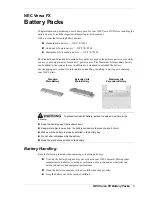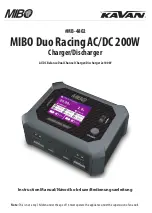
11
3
Restore function
• This function is designed to restore overdischarged batteries. It cannot be selected manually. Restore mode starts
automatically when an overdischarged battery is connected to the charger. A low charging current is used to re-
store the battery to a normal voltage. When the battery reaches its normal voltage, the charger continues to charge
the battery using the normal charging process.
c) Charging time
• The time it takes for the battery to reach its final charging voltage depends on several parameters, such as:
- The capacity (Ah) (batteries with higher capacities take longer to charge)
- The type of battery
- The charging status (full, half-full or empty)
- The ambient temperature (ideally between 20 - 25 °C) and
- The general condition (age) of the battery.
The charging time depends on the above parameters and can be roughly estimated using the following formula:
Charging time (in hours) = Battery capacity (in Ah) x 1.2 / Charging current (in A)
1
Example: 20 Ah lead-gel battery, empty
Approx. charging time 5 hrs = 20 Ah x 1.2 / 5 A
d) Built-in protection features
1
Spark-resistant short-circuit and reverse polarity protection
• These functions protect the charger from damage when the battery cables are connected in reverse polarity.
2
Overvoltage protection
• This function protects sensitive electronic components in the charger against damage caused by high voltages.
3
Charging current regulator
• This function prevents the charger from overheating and damage caused by short or excessive loads.
4
Automatic overtemperature protection
• The overtemperature protection feature prevents damage to the charger caused by abnormal ambient tempera-
tures or faulty components.
The built-in overheat protection feature constantly monitors the temperature of the electronic components.
If the temperature exceeds the preset limit, the current is reduced to prevent the charger from overheating.
This reduces the output current until the temperature has dropped to a safe level.












































